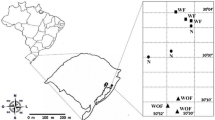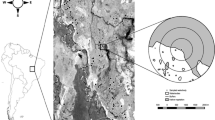Abstract
The debate about management practices that help maintain biodiversity in cultivated areas is an ongoing controversy in conservation biology. It has been suggested that organic agriculture supports greater levels of diversity than non–organic agriculture. This study examined anuran assemblages in natural intermittent ponds and rice fields under two types of cultivation methods (conventional and organic) in southern Brazil. We tested the differences in species richness and composition among assemblages and guilds, at different stages of rice cultivation. Overall, organic fields had a different species composition than conventional fields and natural ponds. Most of the differences observed between the natural areas and the rice fields occurred during the off–season. For semi-aquatic species, richness was higher in off-season and in earlier growing stages. We found no differences in species richness of fossorial and arboreal species across the crop cycle. The differences we observed may relate to differences in dispersal abilities among guilds. Thus, the incorporation of individual traits of each species (e.g., habitat preference and reproductive mode) is fundamental to the creation of more effective conservation strategies in agroecosystems.



Similar content being viewed by others
References
Andersen A, Eltun R (2000) Long-term developments in the carabid and staphylinid (Col., Carabidae and Staphylinidae) fauna during conversion from conventional to biological farming. J Appl Entomol 124:51–56. doi:10.1046/j.1439-0418.2000.00438.x
Attademo AM, Cabagna-Zenklusen M, Lajmanovich RC et al (2011) B-esterase activities and blood cell morphology in the frog Leptodactylus chaquensis (Amphibia: Leptodactylidae) on rice agroecosystems from Santa Fe Province (Argentina). Ecotoxicology 20:274–82. doi:10.1007/s10646-010-0579-8
Azambuja IHV, Vernetti JFJ, Magalhães AM Jr (2004) Aspectos socioeconômicos da produção do arroz. In: Gomes AS, Magalhães A Jr (eds) Arroz irrigado no Sul do Brasil. Arroz irrigado no Sul do Brasil. Embrapa Informação Tecnológica, Brasília, pp 23–44
Bambaradeniya CNB, Edirisinghe JP, Silva DN et al (2004) Biodiversity associated with an irrigated rice agro-ecosystem in Sri Lanka. Biodivers Conserv 13:1715–1753
Becker CG, Fonseca CR, Haddad CFB et al (2007) Habitat split and the global decline of amphibians. Science 318:1775–1777. doi:10.1126/science.1149374
Beebee TJC, Griffiths RA (2005) The amphibian decline crisis: a watershed for conservation biology? Biol Conserv 125:271–285
Beecher NA, Johnson RJ, Brandle JR et al (2002) Agroecology of birds in organic and nonorganic farmland. Conserv Biol 16:1620–1631. doi:10.1046/j.1523-1739.2002.01228.x
Borcard D, Legendre P (2002) All-scale spatial analysis of ecological data by means of principal coordinates of neighbour matrices. Ecol Model 153:51–68
Both C, Solé M, Santos TG, Cechin SZ (2009) The role of spatial and temporal descriptors for neotropical tadpole communities in southern Brazil. Hydrobiologia 624:125–138. doi:10.1007/s10750-008-9685-5
Colombo P, Kindel A, Vinciprova G, Krause L (2008) Composição e ameaças à conservação dos anfíbios anuros do Parque Estadual de Itapeva, município de Torres, Rio Grande do Sul, Brasil. Biota Neotropica 8:229–240
Crump ML, Scott NJ (1994) Standard techniques for inventoring and monitoring: visual encounters surveys. In: Heyer WR, Donelly MA, McDiarmid RW et al (eds) Measuring and monitoring biological diversity. Standard methods for amphibians. Smithsonian Institution Press, Washington, pp 84–92
Cushman SA (2006) Effects of habitat loss and fragmentation on amphibians: a review and prospectus. Biol Conserv 128:231–240. doi:10.1016/j.biocon.2005.09.031
Devine GJ, Furlong MJ (2007) Insecticide use: contexts and ecological consequences. Agric Hum Values 24:281–306
Dixo M, Metzger JP (2010) The matrix-tolerance hypothesis: an empirical test with frogs in the Atlantic Forest. Biodivers Conserv 19:3059–3071. doi:10.1007/s10531-010-9878-x
Donald PF (2004) Biodiversity impacts of some agricultural commodity production systems. Conserv Biol 18:17–37
Doody JS, Osborne W, Bourne D et al (2006) Vertebrate biodiversity on Australian rice farms. Rural Industries Research and Development Corporation, Kingston ACT
Dufrene M, Legendre P (1997) Species assemblages and indicator species: the need for a flexible asymmetrical approach. Ecol Monogr 67:345–366
Duré MI, Kehr AI, Schaefer EF, Marangoni F (2008) Diversity of amphibians in rice fields from northeastern Argentina. Interciencia 33:523–527
Ernst R, Rödel MO (2008) Patterns of community composition in two tropical tree frog assemblages: separating spatial structure and environmental effects in disturbed and undisturbed forests. J Trop Ecol 24:111–120. doi:10.1017/S0266467407004737
FAO Stat. (2010) FAO statistical databases. http://faostat.fao.org. Accessed 8 Aug 2012
Fujioka M, Lane SJ (1997) The impact of changing irrigation practices in rice fields on frog populations of the Kanto Plain, central Japan. Ecol Res 12:101–108. doi:10.1007/BF02523615
Fuller R, Norton L, Feber R et al (2005) Benefits of organic farming to biodiversity vary among taxa. Biol Lett 1:431–434. doi:10.1098/rsbl.2005.0357
Gallant AL, Klaver RW, Casper GS, Lanoo MJ (2007) Global rates of habitat loss and implications for amphibian conservation. Copeia 2007:967–979
Gray MJ, Smith LM, Brenes R (2004) Effects of agricultural cultivation on demographics of southern high plains amphibians. Conserv Biol 18:1368–1377. doi:10.1111/j.1523-1739.2004.00089.x
Guerry AD, Hunter ML Jr (2002) Amphibian distributions in a landscape of forests and agriculture: an examination of landscape composition and configuration. Conserv Biol 16:745–754
Herzon I, Helenius J (2008) Agricultural drainage ditches, their biological importance and functioning. Biol Conserv 141:1171–1183. doi:10.1016/j.biocon.2008.03.005
Hole DG, Perkins AJ, Wilson JD et al (2005) Does organic farming benefit biodiversity? Biol Conserv 122:113–130. doi:10.1016/j.biocon.2004.07.018
IUCN (2013) IUCN Red List of Threatened Species. version 2013.1. http://www.iucnredlist.org. Accessed 17 Feb 2014
Jonason D, Andersson GKS, Ockinger E et al (2011) Assessing the effect of the time since transition to organic farming on plants and butterflies. J Appl Ecol 48:543–550. doi:10.1111/j.1365-2664.2011.01989.x
Kato N, Yoshio M, Kobayashi R, Miyashita T (2010) Differential responses of two anuran species breeding in rice fields to landscape composition and spatial scale. Wetlands 30:1171–1179. doi:10.1007/s13157-010-0103-1
Kwet A, Lingnau R, Di-Bernardo M (2010) Anfíbios da serra gaúcha Pró mata. Edipucrs, Porto Alegre
Machado IF, Maltchik L (2010) Can management practices in rice fields contribute to amphibian conservation in southern Brazilian wetlands? Aquat Conserv Mar Freshwat Ecosyst 20:39–46. doi:10.1002/aqc.1070
Mann RM, Hyne RV, Choung CB, Wilson SP (2009) Amphibians and agricultural chemicals: review of the risks in a complex environment. Environ Pollut 157:2903–2927. doi:10.1016/j.envpol.2009.05.015
Marsh DM, Thakur KA, Bulka KC, Clarke LB (2004) Dispersal and colonization through open fields by a terrestrial, woodland salamander. Ecology 85:3396–3405. doi:10.1890/03-0713
Mazerolle MJ (2004) Drainage ditches facilitate frog movements in a hostile landscape. Landsc Ecol 20:579–590
Moreira LFB, Machado IF, Garcia TV, Maltchik L (2010) Factors influencing anuran distribution in coastal dune wetlands in southern Brazil. J Nat Hist 44:1493–1507. doi:10.1080/00222931003632690
Oksanen J, Blanchet FG, Kindt R, et al. (2013) vegan: Community Ecology Package. http://CRAN.R-project.org/package=vegan
Peltzer PM, Lajmanovich RC, Attademo AM, Beltzer AH (2006) Diversity of anurans across agricultural ponds in Argentina. Biodivers Conserv 15:3499–3513
Peltzer PM, Lajmanovich RC, Sánchez-Hernandez JC et al (2008) Effects of agricultural pond eutrophication on survival and health status of Scinax nasicus tadpoles. Ecotoxicol Environ Saf 70:185–197. doi:10.1016/j.ecoenv.2007.06.005
Piatti L, Souza FL, Filho PL (2010) Anuran assemblage in a rice field agroecosystem in the Pantanal of central Brazil. J Nat Hist 44:1215–1224. doi:10.1080/00222930903499804
Resetaris WJ (2005) Habitat selection behaviour links local and regional scales in aquatic systems. Ecol Lett 8:480–486
Roberts DW (2012) labdsv: ordination and multivariate analysis for ecology. http://cran.r-project.org/package=labdsv
Rossato MS (2011) Os climas do Rio Grande do Sul: variabilidade, tendência e tipologia. Thesis, Universidade Federal do Rio Grande do Sul
Rothermel BB (2004) Migratory success of juveniles: a potential constraint on connectivity for pond-breeding amphibians. Ecol Appl 14:1535–1546
Segalla M V, Caramaschi U, Cruz CAG, et al. (2012) Brazilian amphibians—List of species. http://www.sbherpetologia.org.br. Accessed 5 Sep 2013
Semlitsch RD (2008) Differentiating migration and dispersal processes for pond-breeding amphibians. J Wildl Manag 72:260–267. doi:10.2193/2007-082
SYSTAT (2007) Systat 12 for windows. Version 12.02.00.’. SYSTAT Software Inc, Chicago
Vallan D (2000) Influence of forest fragmentation on amphibian diversity in the nature reserve of Ambohitantely, highland Madagascar. Biol Conserv 96:31–43
Vasconcelos D, Calhoun AJK (2004) Movement patterns of adult and juvenile Rana sylvatica (LeConte) and Ambystoma maculatum (Shaw) in three restored seasonal pools in Maine. J Herpetol 38:551–561
Weibull A-C, Bengtsson J, Nohlgren E (2000) Diversity of butterflies in the agricultural landscape: the role of farming system and landscape heterogeneity. Ecography 23:743–750. doi:10.1111/j.1600-0587.2000.tb00317.x
Werner EE, Skelly DK, Relyea RA, Yurewicz KL (2007) Amphibian species richness across environmental gradients. Oikos 116:1697–1712. doi:10.1111/j.2007.0030-1299.15935.x
Wilson AL, Watts RJ, Stevens MM (2007) Effects of different management regimes on aquatic macroinvertebrate diversity in Australian rice fields. Ecol Res 23:565–572. doi:10.1007/s11284-007-0410-z
Zar JH (1999) Biostatistical analysis. Prentice Hall, New Jersey
Acknowledgments
We thank F. Nomura, N. P. Smaniotto, P. Colombo, and three anonymous referees for helpful comments in a previous version of the manuscript. We are thankful to all private owners that authorized the use of their rice fields for our research. This study is part of the results of the Project “Manejo de arrozais com vistas à conservação da biodiversidade aquática das áreas úmidas do sul do Brasil” of the Laboratório de Ecologia e Conservação de Ecossistemas Aquáticos, UNISINOS. This research was supported by funds from UNISINOS (02.00.023/00–0), Fundação de Amparo a Pesquisa no Rio Grande do Sul–FAPERGS (11/1149–7), and Conselho Nacional de Desenvolvimento Científico e Tecnológico–CNPq (52370695.2). We declare that the data collection complied with Brazilian current laws (Sistema de Autorização e Informação em Biodiversidade–SISBIO n. 24882–2).
Author information
Authors and Affiliations
Corresponding author
Rights and permissions
About this article
Cite this article
Moreira, L.F.B., Maltchik, L. Does Organic Agriculture Benefit Anuran Diversity in Rice Fields?. Wetlands 34, 725–733 (2014). https://doi.org/10.1007/s13157-014-0537-y
Received:
Accepted:
Published:
Issue Date:
DOI: https://doi.org/10.1007/s13157-014-0537-y




